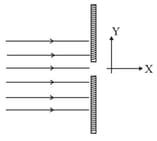EASY
Earn 100
What is the essential condition for Fraunhofer diffraction?
Important Questions on Wave Optics
HARD
MEDIUM
EASY
HARD
EASY

EASY
MEDIUM
EASY
MEDIUM
EASY
EASY
EASY
MEDIUM
EASY
MEDIUM
(i) Fringes are of unequal width
(ii) Fringes are of equal width
(iii) Light energy is conserved
(iv) Intensities of all bright fringes are equal
EASY
EASY
MEDIUM
EASY
EASY

